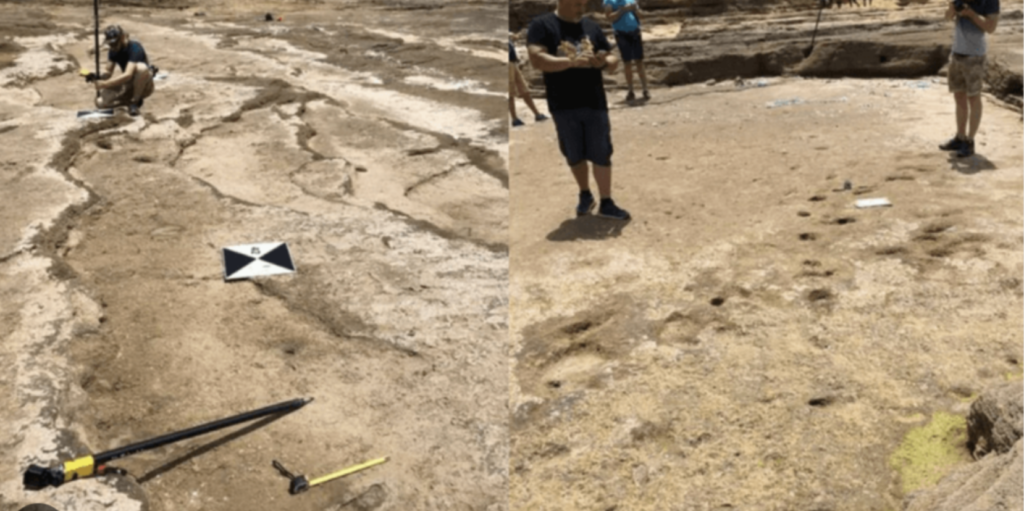Early Human Footprints Found in Morocco, Dating 90,000 Years Ago

By: Masha Lukovenko / Arab America Contributing Writer
While examining boulders at a nearby pocket beach in 2022, researchers stumbled upon the footprint site near the northern tip of Africa. A team of archaeologists has uncovered the oldest known human footprints in North Africa and the southern Mediterranean. The remarkable 90,000-year-old footprints were discovered by a multidisciplinary team under the direction of Moncef Sedrati, a research professor and the head of the Géo-Océan lab at the University of Bretagne Sud in France, on a beach near Larache, Morocco.
By using a state-of-the-art technique called optically stimulated luminescence dating, which determines when a particular mineral was last exposed to heat or sunshine, Essedrati and his team were able to establish when a multigenerational group of Homo sapiens walked on the gently sloping beach, some 90,000 years ago. The research, published in the journal Nature, illuminated a set of 85 footprints found on two pathways ascribed to at least five ice-era individuals. The footprints belonged to various age groups, including children, teenagers, and adults. The Larache researchers hypothesize that the children ambling along the beach 90,000 years ago may have aided in that search, though further studies will be needed to validate this theory.
Despite ongoing erosion threatening the Larache archaeological site’s longevity, the footprints were likely preserved due to the favorable beach layout, fair-weather wave conditions, and tidal reach. The researchers now aim to uncover why the ice age group was on the beach through further analysis, including exploring various caves along Larache’s southern coastline. These are among the earliest prints of Homo sapiens globally and the oldest human prints discovered in the area. Footprints are snapshots in time that include fascinating information on various subjects, including social behavior, speed, gait, and physical characteristics like age, mass, and stature.
The last 90,000 years have seen about 78 feet of sediment deposited above the level of the footprints, Mouncef Sedrati, a life sciences professor at France’s University of South Brittany and a co-author of the study, said in an interview.
“I told my team that we should go north to explore another beach between tides. We were surprised to find the first print. At first, we weren’t convinced it was a footprint, but we found more of the trackway. It is possible that the cliff, on which the layer of footprints currently forms the base, began to erode in recent years due to the frequent occurrence of storms,” Sedrati stated. “As a result, the rocky platform started to crumble, exposing the footprints as it went until it reached its current level.” It’s unknown what, exactly, the ancient humans were doing on the shore. It’s possible that they were only traveling via two paths. However, given that our Pleistocene ancestors were hunters and gatherers, and previous research.
What the prehistoric humans were doing specifically on the shore is unknown. It’s possible that they were only traveling via two paths. However, given that our Pleistocene ancestors were hunter-gatherers and that coastal areas were crucial to their resource collection, it seems likely that they were scavenging for food. Their tracks’ perpendicular orientation to the coast points to a hunt for marine food.
“It adds to other evidence that the Middle Stone Age inhabitants of Morocco were visiting the coast, presumably in search of food and other items,” Louise Humphrey, a bioarchaeologist with London’s Natural History Museum who was not part of the research team, said in an email. “What is particularly exciting about this discovery is the paleontological and paleoanthropological potential it provides,” Sedrati said. “We have only examined the best-preserved 85 footprints. More human and potentially animal prints remain to be explored and studied.”
Morocco is also home to the Jebel Irhoud archaeological site, where scientists discovered the earliest known fossilized remains of homo sapiens, dating back 300,000 years. The oldest known homo sapiens footprints, found in South Africa, date back 153,000 years. This is a fascinating archaeology and world history discovery that the global community must study and preserve. These ancient footprints could easily be washed away by millennia of strong ocean tides. Still, they got held to show and offer us a deep historical look into the early homo sapiens’ history.
Check out Arab America’s blog here!


